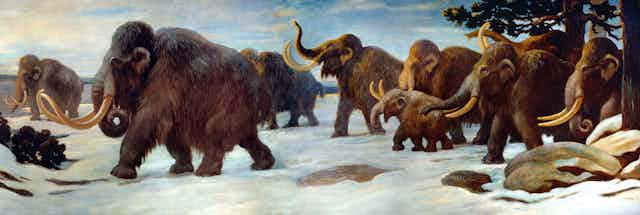It’s well known that carbon in the atmosphere is causing global warming. What is less well known, outside of scientific circles at least, is the role oceans have to play in this. Our seas contain 60 times more carbon than the atmosphere, and they can release it at sufficiently rapid rates to cause dramatic changes in the climate. In fact, as we describe in research published in Nature, CO2 released by the oceans brought about the end of the last ice age.
More than 50 million cubic kilometres of ice once covered North America and Scandinavia. It melted away between approximately 19,000 and 10,000 years ago, releasing enough water to raise the sea level by about 130 metres. This came after CO2 concentrations increased by approximately 50%, from 180 to 280 parts per million between the last ice age and the current interglacial period. To explain such a pronounced increase, we have to look at the ocean.
Scientists have thought for a long time that the southern sectors of the Atlantic, Indian and Pacific Oceans, a region known as the Southern Ocean, may be key to explaining the increase in atmospheric CO2.
Large volumes of deep water loaded with carbon come to the surface in this area. However, the low concentration of certain nutrients (for example iron) in surface waters limits the metabolism of planktonic organisms, which cannot fully consume all the carbon brought to the surface ocean, resulting in CO2 being “outgassed” to the atmosphere.
We wanted to assess if the ocean contributed to the atmospheric CO2 increase during the last deglaciation, so it made sense to look at areas that are important today for the ocean-atmosphere exchange of carbon: the Atlantic Sector of the Southern Ocean and the Eastern Equatorial Pacific, another area where deep, cold water rises to the surface.
But how can we then go back in time and check if these areas were a source of CO2 in the atmosphere? The answer is buried a few thousand meters below the surface of the oceans.

Research vessels such as the Joides Resolution are capable of drilling the sea floor to recover long sequences of sediments in which the history of the oceans is recorded. The sediments contain, among other things, fossils of tiny organisms that once lived in the upper ocean, called foraminifera. These creatures build chalky shells, and the waters they live in influence their chemical composition.
After death, the shells sink to the bottom of the oceans, where they accumulate. We analysed the sediment cores and looked for the isotopic composition of the element boron present in shells that lived during particular times of interest. Boron tells us pH levels of the waters, which in turn tells us about carbon levels: a high concentration of CO2 in the waters will make them more acidic (lower pH), and vice versa.
We found a link. When the glaciers of the last ice age were melting, and the atmospheric CO2 was increasing, the surface waters of the Southern Ocean and the Eastern Equatorial Pacific were also more acidic. This signalled an increased concentration of CO2 – much higher than those in the atmosphere.
This is the key finding of our research: the ocean was a source of CO2 to the atmosphere during key intervals of the last deglaciation, which explains the large increase in CO2 concentrations.
Where did this carbon come from?
It’s the next obvious question. Previous research has found that the last ice age saw much less carbon exchanged between ocean and atmosphere than we see today, mostly because the Southern Ocean was intensely stratified at the time and deep waters rarely made it to the surface. Nutrients and CO2 were accumulating in the deep Southern Ocean, due to the decay of the organic matter that was being produced in the surface ocean and transported to the abyss.

During the deglaciation, the effective communication between deep and upper ocean was re-established, and this carbon “reservoir” was leaked to the atmosphere.
Since the beginning of the industrial revolution the oceans have absorbed an estimated 155 billion tonnes of carbon, about 30% of the total human emissions. The present atmospheric CO2 concentrations, approximately 400 parts per million, have not been seen on Earth since the Pliocene, around 3 million years ago, and the rate of increase is unprecedented in the period of on-off glaciers we have had since.
Humanity is performing a large scale experiment with the Earth, and the consequences are already being seen in the form of increased atmospheric and oceanic temperatures, raising sea levels and ocean acidification, to name a few. How the oceanic uptake of CO2 is going to operate in the future remains unknown, but studies like ours advance our understanding of how the ocean works to store and release carbon on timescales of millennia and that therefore are way beyond the reach of the instrumental record.

